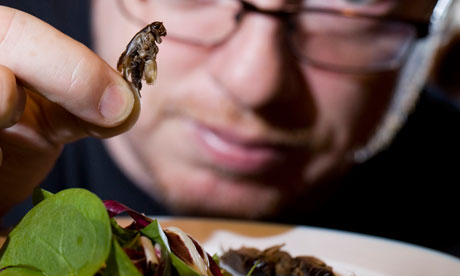
"Is it not a wonder", he asked, "that people do not look around them for the many gastronomic treasures lying neglected at their feet? Prejudice, prejudice, thy strength is enormous!" As Victorian kitchen classics go, this flimsy tract might not be viewed with the same affection as more famous works by Isabella Beeton or Agnes Marshall, but it's quite possible that Holt's time has at last arrived.
The UN appears to think so. Their Food and Agriculture Organisation is exploring the possibilities of insects providing a greater share of global food needs, and the statistics appear to suggest that a future of crunchy critter consumption isn't beyond the realms of possibility.
With the planet's population heading ever more rapidly towards the seven billion mark (we'll get there in October) and an ever-less-economical reliance on meat, farmed insects might just provide an answer. They produce much more meat per kilogram of feed than the more usual farmed animals do, and more of their body mass is edible.
What's more, they produce a fraction of the greenhouse gasses pumped out by cattle and are rich in minerals, vitamins and proteins. Just four locusts provide as much calcium as a glass of milk, while mopani worms, gram-for-gram, contain more protein than beef.
Insects are already eaten in four-fifths of nations, from the grasshopper tacos popular in Mexico to China, where almost anything goes. I once pointed at a piece of delicious, dripping honeycomb on display at a restaurant in Xi'an, Shaanxi province, and was somewhat surprised to be served a plateful of baby bees.
Elsewhere, western tourists are approaching the idea of insect and arachnid cuisine with more open minds. The consumption of a delicious Cambodian deep-fried tarantula was once the preserve of macho food tourists like Anthony Bourdain. Then the experience was added to the gap-year checklist alongside full moon parties in Koh Phangan and bungee jumps in Queenstown. The signs are that the "edible insect movement" is finally being treated much more seriously with chefs getting in on the act. Even the New Yorker, that bible of urban sophistication, recently devoted 6,500 words to the subject.
But insects taste terrible, right? Well, perhaps not. In his introduction to Man Eating Bugs‚ The Art and Science of Easting Insects author Peter Menzel writes that a toasted witchetty grub tastes like "a tender cheese omelette rolled in a smoky philo-dough shell" and that Ugandan termites are akin to "roasted peanut skins, only juicier".
Suspicious that Mr Menzel has a book-selling agenda that renders him incapable of saying bad things about such morsels, I make my way to the Natural History Museum in London's swinging Kensington, where an event is being held. It's called "Edible insects: food for the future? A tasting event with a difference", and a trio of experts are lined up to inform the uninformed.
There's the NHM's resident insect identifier Stuart Hine, Meredith Alexander, a "hunger expert" for the charity ActionAid, and Daniel Creedon, head chef at Archipelego, on whose menu chilli and garlic locusts nestle comfortably alongside chocolate-covered scorpions.
The first thing we discover is that we're already eating insects. And yes, that "we" includes you. That delicious bar of chocolate you've saved for later? In all probability it contains 60 or more insect fragments (a type of contamination known in the trade as "insect filth"). That sweetcorn? The average tin is home to a couple of sizeable larvae chunks. And frozen broccoli? You really, really don't want to know.
The knowledge that we're already seasoned insect eaters, albeit unwittingly, makes the food that follows easier to swallow for the assembled diners. The waxworm larvae have a very subtle sweetness, while the fried crickets leave a pleasantly nutty aftertaste. Toasted weaver ants taste of very little‚ not even toast, and the chocolate ant wafers are delicious but taste almost entirely of chocolate.
My favourite treat is an off-menu item, a scorpion dipped in chocolate and possessing a gentle alcoholic kick. The worst? No-one seems keen on the silkworm pupae. South Koreans buy these like crisps at convenience stores, but they don't go down well here. "Like rancid fish sauce", says Creedon.
In between courses it's Q&A time. Which wine works best with insects? The answer, apparently, is "beer". How many locusts would one need to eat for breakfast to replace two eggs? "About 74", says Hine, tongue firmly in cheek. Is the recent tourist predilection for spiders endangering the tarantula population? Can one eat insects or arachnids live? Are insects sentient beings capable of sensing cruelty? Hine suggests not, but a vegan in the audience argues that while insects might not be able to philosophise, you could say the same of most humans, obsessed as they are with the X-Factor and EastEnders. Yeah! In your face, science!
As the evening draws to a close, one gentleman rises from his seat, sheepishly makes his way forward, and offers the evening's host a small bowl containing a single silkworm pupa. It looks for all the world like some kind of demented courtship gesture. Reluctantly, she pops it in her mouth, and instinctively makes the kind of sour, scrunched face only worn by those with a desperate, sudden need for a glass of water and a toothbrush. At this very moment, assuming bugs haven't entirely consumed him, Vincent M Holt is probably spinning furiously in his grave.












